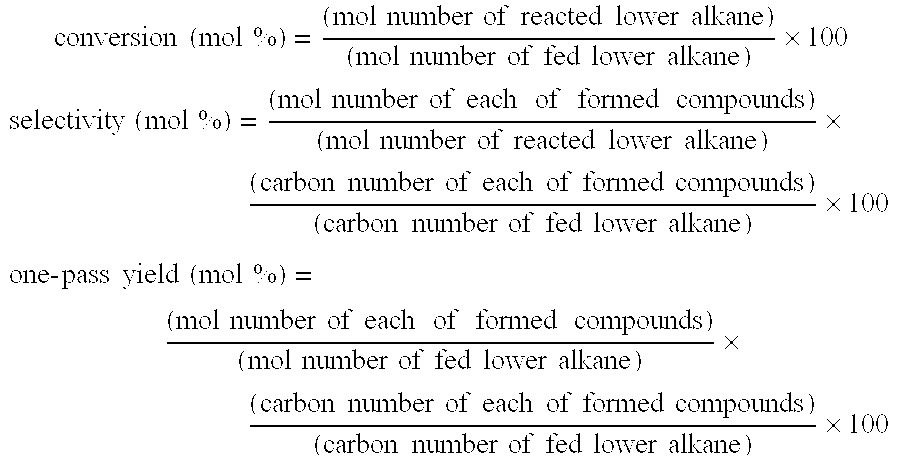Lower alkane oxidative dehydrogenation catalysts and a process for producing olefins
- Summary
- Abstract
- Description
- Claims
- Application Information
AI Technical Summary
Benefits of technology
Problems solved by technology
Method used
Image
Examples
example 1
A 1-liter beaker was charged with 109.4 g of alumina sol A-200 (Nissan Chemical Industries, Co., Al.sub.2 O.sub.3 concentration: 10.5%), 16.0 g of silica sol Snowtex N (Nissan Chemical Industries, Co., SiO.sub.2 concentration: 20.5%) and 150 ml of water, and the content was heated to about 80.degree. C. under stirring. Separately, in a 500-ml beaker 100 ml of water was added to 1.77 g of ammonium paramolybdate [(NH.sub.4)Mo.sub.7 O.sub.24.multidot.4H.sub.2 O: Wako Pure Chemical Industry, Ltd., special grade reagent] to dissolve it under heating and stirring. To the solution, 8.35 g of aqueous ammonium metatungstate [(NH.sub.4).sub.6 H.sub.2 W.sub.12 O.sub.48) solution MW-2 (Nippon Inorganic Colour and Chemical Co., Ltd.), containing 50% of WO.sub.3 ] as diluted with 50 ml of water was added, followed by further addition of 3.07 g of Sb.sub.2 O.sub.3 powder (Wako Pure Chemical Industry, Ltd., purity 99.9%) as dispersed in 100 ml of water with homogenizer, and 2 hours' stirring at abo...
example 2
A 1-liter beaker was charged with 109.4 g of alumina sol A-200 (Nissan Chemical Industries, Co.) 16.0 g of silica sol Snowtex N (Nissan Chemical Industries, Co.) and 150 ml of water, and the content was heated to about 80.degree. C. under stirring. Separately, in a 500-ml beaker 100 ml of water was added to 1.77 g of ammonium paramolybdate (Wako Pure Chemical Industry, Ltd., special grade reagent) to dissolve it under heating and stirring. To the resulting solution, 9.27 g of aqueous ammonium metatungstate solution MW-2 (Nippon Inorganic Colour and Chemical Co., Ltd.) as diluted with 50 ml of water was added, followed by further addition of 0.14 g of ammonium metavanadate (Wako Pure Chemical Industry, Ltd., special grade reagent) as dissolved in 50 ml of water under heating, and 3.65 g of Sb.sub.2 O.sub.3 powder (Wako Pure Chemical Industry, Ltd., purity 99.9%) as dispersed in 100 ml of water with homogenizer, by the order stated. The system was stirred for 2 hours at about 80.degre...
example 3
A catalyst was prepared in the same manner as in Example 2, except that the amount of the ammonium paramolybdate was changed to 1.34 g, that of the aqueous ammonium metatungstate solution MW-2, to 8.77 g, that of the ammonium metavanadate, to 0.22 g and that of the Sb.sub.2 O.sub.3 powder, to 3.31 g. The composition of the resulting catalyst was as follows:
40% (Mo.sub.1 Sb.sub.3.0 W.sub.2.5 V.sub.0.25 O.sub.x) / [47% (Al.sub.2 O.sub.3)-13% (SiO.sub.2)].
Using this catalyst, the reaction was carried out under identical conditions with those of Example 1, except that the reaction temperature was changed to 500.degree. C. The results were as shown in Table 1.
PUM
| Property | Measurement | Unit |
|---|---|---|
| Fraction | aaaaa | aaaaa |
| Fraction | aaaaa | aaaaa |
| Fraction | aaaaa | aaaaa |
Abstract
Description
Claims
Application Information
 Login to View More
Login to View More - R&D
- Intellectual Property
- Life Sciences
- Materials
- Tech Scout
- Unparalleled Data Quality
- Higher Quality Content
- 60% Fewer Hallucinations
Browse by: Latest US Patents, China's latest patents, Technical Efficacy Thesaurus, Application Domain, Technology Topic, Popular Technical Reports.
© 2025 PatSnap. All rights reserved.Legal|Privacy policy|Modern Slavery Act Transparency Statement|Sitemap|About US| Contact US: help@patsnap.com

